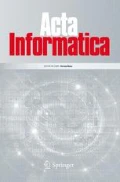Summary
Given a formulation of a problem, a compact representation is required both for theoretical purposes — measuring the complexity of algorithms, and for practical purposes — data compression.
The adjacency lists method for representing graphs is compared to the information theoretic lower bounds, and it is shown to be optimal in many instances. For n-vertex labeled planar graphs the adjacency lists method requires 3nlogn + O(n) bits, a linear algorithm is presented to obtain a 3/2nlogn + O(n) representation while nlogn + O(n) is shown to be the minimum.
Similar content being viewed by others
References
Erdös, P., Spencer, J.: Probabilistic methods in combinatorics. Academic Press 1974
Gallager, R.G.: Information theory and reliable communication. John Wiley and Sons 1968
Hopcroft, J., Tarjan, R.: Efficient planarity testing. JACM 21, 549–568 (1974)
Liu, C.L.: Introduction to combinatorial mathematics. McGraw-Hill 1968
Tutte, W.T.: The enumerative theory of planar maps. In: A survey of combinatorial theory. J.N. Srivastava, Havary, F., Rao, C.R., Rota, G.-C, Shrikhande, S.S. (eds.). North-Holland Publishing Company 1973
Author information
Authors and Affiliations
Rights and permissions
About this article
Cite this article
Itai, A., Rodeh, M. Representation of graphs. Acta Informatica 17, 215–219 (1982). https://doi.org/10.1007/BF00288971
Received:
Issue Date:
DOI: https://doi.org/10.1007/BF00288971




